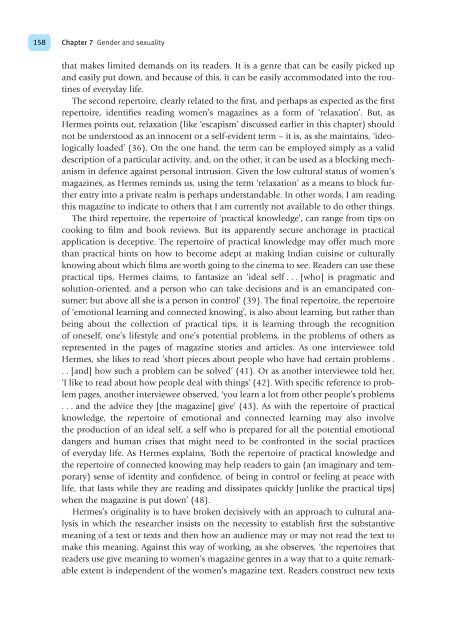Cultural Theory and Popular Culture
Cultural Theory and Popular Culture
Cultural Theory and Popular Culture
Create successful ePaper yourself
Turn your PDF publications into a flip-book with our unique Google optimized e-Paper software.
158<br />
Chapter 7 Gender <strong>and</strong> sexuality<br />
that makes limited dem<strong>and</strong>s on its readers. It is a genre that can be easily picked up<br />
<strong>and</strong> easily put down, <strong>and</strong> because of this, it can be easily accommodated into the routines<br />
of everyday life.<br />
The second repertoire, clearly related to the first, <strong>and</strong> perhaps as expected as the first<br />
repertoire, identifies reading women’s magazines as a form of ‘relaxation’. But, as<br />
Hermes points out, relaxation (like ‘escapism’ discussed earlier in this chapter) should<br />
not be understood as an innocent or a self-evident term – it is, as she maintains, ‘ideologically<br />
loaded’ (36). On the one h<strong>and</strong>, the term can be employed simply as a valid<br />
description of a particular activity, <strong>and</strong>, on the other, it can be used as a blocking mechanism<br />
in defence against personal intrusion. Given the low cultural status of women’s<br />
magazines, as Hermes reminds us, using the term ‘relaxation’ as a means to block further<br />
entry into a private realm is perhaps underst<strong>and</strong>able. In other words, I am reading<br />
this magazine to indicate to others that I am currently not available to do other things.<br />
The third repertoire, the repertoire of ‘practical knowledge’, can range from tips on<br />
cooking to film <strong>and</strong> book reviews. But its apparently secure anchorage in practical<br />
application is deceptive. The repertoire of practical knowledge may offer much more<br />
than practical hints on how to become adept at making Indian cuisine or culturally<br />
knowing about which films are worth going to the cinema to see. Readers can use these<br />
practical tips, Hermes claims, to fantasize an ‘ideal self . . . [who] is pragmatic <strong>and</strong><br />
solution-oriented, <strong>and</strong> a person who can take decisions <strong>and</strong> is an emancipated consumer;<br />
but above all she is a person in control’ (39). The final repertoire, the repertoire<br />
of ‘emotional learning <strong>and</strong> connected knowing’, is also about learning, but rather than<br />
being about the collection of practical tips, it is learning through the recognition<br />
of oneself, one’s lifestyle <strong>and</strong> one’s potential problems, in the problems of others as<br />
represented in the pages of magazine stories <strong>and</strong> articles. As one interviewee told<br />
Hermes, she likes to read ‘short pieces about people who have had certain problems .<br />
. . [<strong>and</strong>] how such a problem can be solved’ (41). Or as another interviewee told her,<br />
‘I like to read about how people deal with things’ (42). With specific reference to problem<br />
pages, another interviewee observed, ‘you learn a lot from other people’s problems<br />
. . . <strong>and</strong> the advice they [the magazine] give’ (43). As with the repertoire of practical<br />
knowledge, the repertoire of emotional <strong>and</strong> connected learning may also involve<br />
the production of an ideal self, a self who is prepared for all the potential emotional<br />
dangers <strong>and</strong> human crises that might need to be confronted in the social practices<br />
of everyday life. As Hermes explains, ‘Both the repertoire of practical knowledge <strong>and</strong><br />
the repertoire of connected knowing may help readers to gain (an imaginary <strong>and</strong> temporary)<br />
sense of identity <strong>and</strong> confidence, of being in control or feeling at peace with<br />
life, that lasts while they are reading <strong>and</strong> dissipates quickly [unlike the practical tips]<br />
when the magazine is put down’ (48).<br />
Hermes’s originality is to have broken decisively with an approach to cultural analysis<br />
in which the researcher insists on the necessity to establish first the substantive<br />
meaning of a text or texts <strong>and</strong> then how an audience may or may not read the text to<br />
make this meaning. Against this way of working, as she observes, ‘the repertoires that<br />
readers use give meaning to women’s magazine genres in a way that to a quite remarkable<br />
extent is independent of the women’s magazine text. Readers construct new texts
















